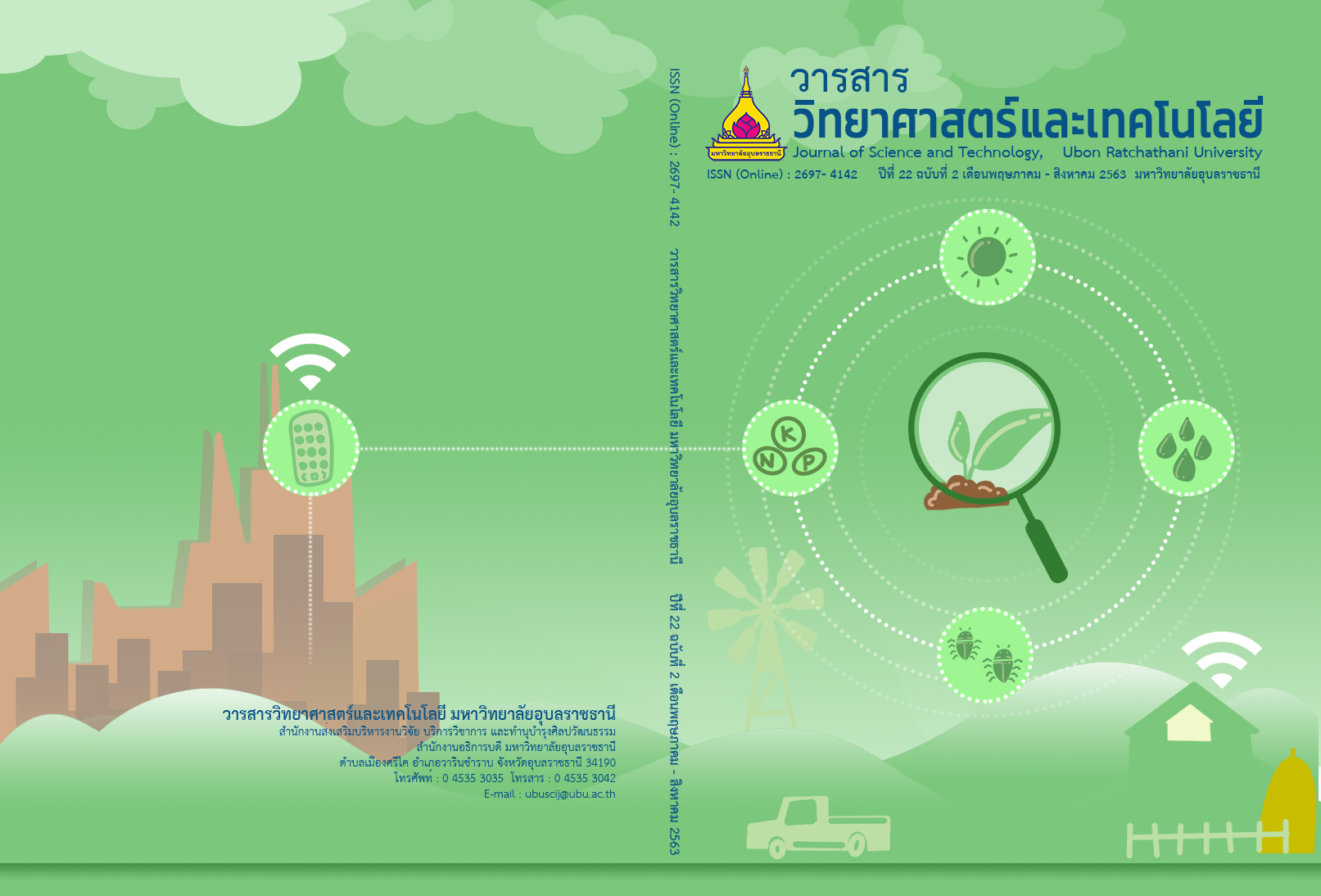พลวัตประชากรและชีววิทยาการสืบพันธุ์ของปูแสมสามชนิดในป่าชายเลนจังหวัดตราด
Main Article Content
บทคัดย่อ
การศึกษาพลวัตประชากรและชีววิทยาการสืบพันธุ์ของปูแสมดำเนินการในพื้นที่ป่าชายเลนจังหวัดตราด พบว่าปูแสมก้ามแดง (Episesarma singaporense) พบมากสุดในองค์ประกอบผลจับ รองลงมาได้แก่ ปูแสมก้ามม่วง (Episesarma mederi) และ ปูแสมก้ามขาว (Episesarma versicolor) ตามลำดับ ปูแสมทุกชนิดมีรูปแบบการเติบโตที่ขนาดและน้ำหนักมีการเพิ่มขึ้นไม่สัมพันธ์กันในรูปแบบกำลังสาม ค่าพารามิเตอร์การเติบโตของปูแสมก้ามแดง ปูแสมก้ามม่วง และ ปูแสมก้ามขาว มีค่าความกว้างกระดองนอกสูงสุดเฉลี่ยที่จะเติบโตได้เท่ากับ 4.40 4.10 และ 4.20 เซนติเมตร ตามลำดับ โดยมีค่าสัมประสิทธิ์การเติบโตเท่ากันคือ 1.51 ต่อปี ค่าสัมประสิทธิ์การตายรวมมีค่าเท่ากับ 7.45 8.40 และ 8.18 ต่อปี ตามลำดับ ขณะที่ค่าสัมประสิทธิ์การตายโดยธรรมชาติมีค่าเท่ากันคือ 2.35 ต่อปี ค่าสัมประสิทธิ์การตายโดยการประมงเท่ากับ 5.10 6.05 และ 5.83 ต่อปี แสดงถึงระดับการใช้ประโยชน์ ณ ปัจจุบันเท่ากับ 0.68 0.72 และ 0.71 ตามลำดับ ปูแสมที่ศึกษาพบมีไข่นอกกระดองมากในสองช่วงของปี ได้แก่ช่วงต้นปีระหว่างเดือนมีนาคมถึงเดือนมิถุนายน และช่วงปลายปีตั้งแต่เดือนสิงหาคมถึงเดือนธันวาคม ปูแสมก้ามแดง ปูแสมก้ามม่วง และปูแสมก้ามขาวที่พบมีไข่นอกกระดองมีขนาดความกว้างกระดองนอกเฉลี่ยเท่ากับ 3.42+0.32 3.35+0.29 และ 3.45+0.29 เซนติเมตร ตามลำดับ
คำสำคัญ : ปูแสม การเติบโต การตาย ระดับการใช้ประโยชน์ ฤดูวางไข่
Article Details
บทความที่ได้รับการตีพิมพ์เป็นลิขสิทธิ์ของ วารสารวิทยาศาสตร์และเทคโนโลยี มหาวิทยาลัยอุบลราชธานี
ข้อความที่ปรากฏในบทความแต่ละเรื่องในวารสารวิชาการเล่มนี้เป็นความคิดเห็นส่วนตัวของผู้เขียนแต่ละท่านไม่เกี่ยวข้องกับมหาวิทยาลัยอุบลราชธานี และคณาจารย์ท่านอื่นๆในมหาวิทยาลัยฯ แต่อย่างใด ความรับผิดชอบองค์ประกอบทั้งหมดของบทความแต่ละเรื่องเป็นของผู้เขียนแต่ละท่าน หากมีความผิดพลาดใดๆ ผู้เขียนแต่ละท่านจะรับผิดชอบบทความของตนเองแต่ผู้เดียว
เอกสารอ้างอิง
[2] Gayanilo, F.C., Jr, and Pauly, D. 1997. FAO-ICLARM Stock Assessment Tools (FiSAT) reference manual. Rome: Food and Agriculture Organization of the United Nations.
[3] Bertalanffy, L. von. 1938. A quantitative theory of organic growth. Human Biology 10: 181-213.
[4] Sparre, P. and Venema, S.C. 1998. Introduction to tropical fish stock assessment, Part 1-manual. Rome: Food and Agriculture Organization of the United Nations.
[5] Pauly, D. 1980. On the interrelationships between natural mortality, growth parameters and mean environmental temperature in 175 fish stocks. Journal du Conseil/Conseil Permanent International pour l'Exploration de la Mer 39(3): 175-192.
[6] Beverton, R.J.H. and Holt, S.J. 1957. On the dynamics of exploited fish population. London: Fisheries Investment.
[7] Finney D.J. 1947. Probit analysis: a statistical treatment of the sigmoid response curve. England: Cambridge University Press.
[8] Koolkalya, S., Sawusdee A. and Jutagate, T. 2015. Chronicle of marine fisheries in the Gulf of Thailand: variations, trends and patterns. Indian Journal of Geo-Marine Sciences 44(9): 1302-1309.
[9] Conti, L. and et al. 2012. Long-term changes and recurrent patterns in fisheries landings from Large Marine Ecosystems (1950–2004), Fisheries Research 119– 120: 1–12.
[10] Hyun, K. and et al. 2005. Using an artificial neural network to patternize long-term fisheries data from South Korea. Aquatic Sciences 67: 382–389.
[11] Buijse, A.D., van Densen, W.L.T. and Machiels, M.A.M. 1991. Characteristics in the annual variation of yield from professional fisheries in freshwater bodies of the temperate and the tropical zones. In: I.G. Cowx (ed.) Catch and Effort Sampling Strategies: Their Applications in Freshwater Fisheries Management, London: Fishing News Book.
[12] Pauly, D. and et al. 1998. Fishing down marine food webs. Science 279: 860-863.
[13] Chuensri, C. 1982. Mangrove brachyuran crabs in Thailand. Bankok: Kasersart University. (in Thai)
[14] Prakunveerawat, S. and Jarernpornnipat, A. 2014. Distribution and abundance of sesarmidae crabs in family sesarmidae in Klong Chaiya Mangrove Estuary, Suratthani Province. King Mongkut's Agricultural Journal 32(1): 40-49. (in Thai)
[15] Kon, K., Kurokura, H. and Tongnunui, P. 2010. Effects of the physical structure of mangrove vegetation on a benthic faunal community. Journal of Experimental Marine Biology and Ecology 383: 171–180.
[16] Sabuytua, B. 2006. Ecology and fishery biology of Grapsid crabs genus Neoepisesarma in Pak Phanang mangrove forests, Nakhon Si Thammarat province. M.Sc. Thesis, Chulalongkorn University. (in Thai)
[17] Ribeiro, F.B., Cascon, H.M. and Bezerra, L.E.A. 2013. Morphometric sexual maturity and allometric growth of the crab Sesarma rectum Randall, 1840 (Crustacea: Sesarmidae) in an impacted tropical mangrove in northeast Brazil. Latin American Journal of Aquatic Research 41(2): 361-368.
[18] Negreiros-Fransozo, M.L., Colpo, K.D. and Costa, T.M. 2003. Allometric growth in the fiddler crab uca thayeri (brachyura, ocypodidae) from a subtropical mangrove. Journal of Crustacean Biology 23(2): 273–279.
[19] Sudtongkong, C. Sophmoa, P. and Srichumpol, W. 2003. Population dynamics of Sesarma (Chiromantes) eumolope, population in Pak Nakhon mangrove, Nakhon Si Thammarat Province. Trang Province: Rajamangala University of Technology Srivijaya. (in Thai)
[20] Suephiran, C. and Phromkamnerd, W. 2003. Population dynamics of Sesarma (Sesarma) brockii, population in mangrove area of Rajamangala University of Technology Srivijaya, Trang Province. Trang Province: Rajamangala University of Technology Srivijaya. (in Thai)
[21] Singkham, P. 2009. Fecundity, hatchability, survival and growth of sesarmid crabs (Episesarma versicolor Tweedie) collected from mangrove area, The King's Royalty Initiated Laem Phak Bia Environmental Research and Development project. M.Sc. Thesis, Kasetsart University. (in Thai)
[22] Dangdee, S, Kong-oh, S. and Sudtongkong C. 2014. Fecundity and hatching rate of the sesarmid crab Episesarma singaporense. Journal of Fisheries Technology Research 8(2): 1-9. (in Thai)
[23] Gulland, J.A. 1971. The fish resources of the ocean. Surrey: Fishing News Ltd.
[24] Gulland, J.A. 1979. Report of FAO/IOP workshop on the fishery resources of the western Indian South of the Equator. Rome: Food and Agriculture Organization of the United Nations.


